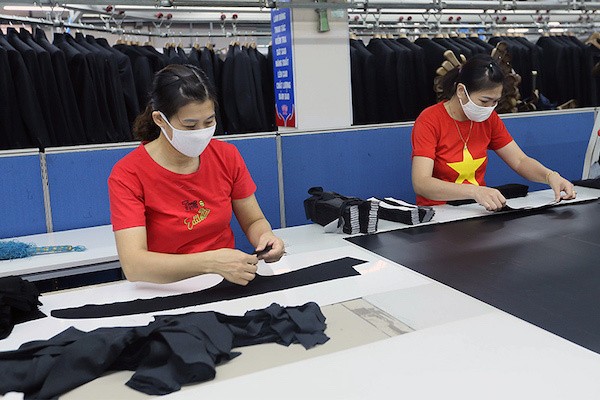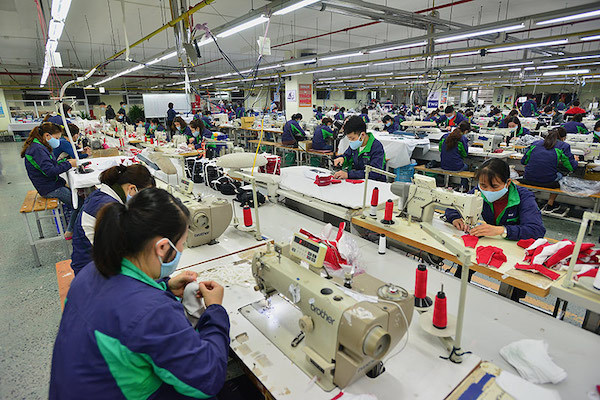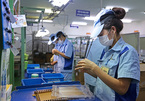 |
|
Textile-garment and footwear have always been key exports and job creation industries, making important contributions to Vietnam’s socio-economic development. Photo: Le Anh Dung
|
The pandemic has disrupted supply and production chains, particularly in these two industries.
According to the General Department of Customs, in January-October this year, the export value of textiles and garments reached US$26.1 billion, up 5.5% or $1.35 billion over the same period last year. Notably, exports to the US market were valued at $12.8 billion, up more than 10%; to the EU $2.6 billion, up over 1%; and to Japan $2.6 billion, down 11% year on year.
At the same time, footwear exports were valued $14.24 billion, up 5.2%, equivalent to an increase of nearly $710 million year on year. The major markets were the US with $5.98 billion, up over 18%; the EU $3.24 billion, up over 7%; China $1.26 billion, down nearly 26% over the same period of last year.
However, under the impact of the Covid-19 pandemic, which resulted in lockdowns in 23 provinces in the country, Vietnam’s footwear export turnover in Q3/2021 was $2.925 billion, down by nearly 48% compared to Q2 and down 27% year on year. Among Vietnam’s export items, footwear saw the highest fall in turnover in Q3/2021 compared to Q2, when it fell by $2.67 billion.
Textile-garment and footwear have always been key exports and job creation industries, making important contributions to Vietnam’s socio-economic development.
However, these industries are largely dependent on imported raw materials. According to a report from the Public-Private Cooperation Group for the Sustainable Development of the Textile and Footwear Industry, about 65% of Vietnam's garment and footwear factories still receive export orders in the Cut- Make-Trim (CMT) form. Accordingly, Vietnamese factories only process products, and do not participate in the downstream stages with higher added value such as purchasing raw materials or design.
CMT does not require complex skills such as material sourcing, design, and supply chain management, and large financial resources. But the profit margin of CMT orders is low. Also, factories often have to sign contracts through intermediary companies. During the Covid-19 crisis, they have faced risks because intermediary companies canceled or postponed orders without giving prior notice, so many factories fell into difficulties or even went bankrupt.
According to the Ministry of Industry and Trade, Vietnamese textile and footwear enterprises are currently only involved in the processing stage, and are not yet self-sufficient in raw materials, and at the same time they are very weak at fashion design and brand building and management. This lowers the added value in these two industries.
Free trade agreements
 |
|
|
In the Comprehensive and Progressive Agreement for Trans-Pacific Partnership (CPTPP), enterprises only benefit when they can produce materials from “yarn” or more, and in the European Union–Vietnam Free Trade Agreement (EVFTA) and the Vietnam-Japan Free Trade Agreement, they benefit if they are able to produce "fabric” or more.
Nguyen Thi Thu Trang, Director of the Center for World Trade and Integration, under the Vietnam Chamber of Commerce and Industry, said that in order to enjoy tariff preferences from free trade agreements (FTAs), local textile and garment producers must meet very strict requirements on origin under each agreement.
Vietnamese agencies are drafting a strategy for the development of the textile and footwear industry in 2021-2030, with a vision to 2035, aiming to promote local firms’ investments in weaving and dyeing and increasing the localization rate.
Commenting on the draft, Tran Huu Huynh, former director of the Vietnam International Arbitration Center (VIAC), said that 30 years ago, Vietnam had a strategy for the textile industry. “I see many ideas in this draft strategy that are similar to that one. In particular, the focus is how to localize products. I wonder that 30 years ago the goal was set to raise this ratio to 50-70%, but now in the draft, it only sets the goal at about 40-50%," Huynh said.
Enterprises in the textile and dying industry are interested in this draft. A director of a foreign-invested textile-dyeing factory said: “The Covid-19 pandemic has increased our interest in yarn sources right in Vietnam instead of imported goods. This reduces shipping costs and time. We have contacted a number of local businesses and want to expand the connections to take advantage of Vietnam's new generation of FTAs.”
According to the Ministry of Industry and Trade, textile-garment and footwear are among the industries with the largest domestic market due to the relatively large population, as well as the increase in people’s daily living standards and per capita income.
These two industries also have great opportunities when the export market expands as Vietnam has signed many free trade agreements with many countries and regions around the world.
Garment production is also shifting to developing countries, including Vietnam, thereby creating more opportunities and new resources for local businesses in terms of access to capital, equipment, production technology, advanced management experience, and skilled labor from developed countries.
But if they only import raw materials for production, or only use the CMT method, these two industries will find it very difficult to rise up in the global value chain.
Lan Anh

Extending the dream of modernization
The goal of industrialization and modernization of the country to 2020 was set at the 8th National Party Congress in 1996 and it has gone through to the 13th National Party Congress in 2021.

When everything must be imported: developing a better support industry
If it does not take advantage of opportunities, Vietnam will need at least two more decades to reach the per capita added value in the processing and manufacturing industry for newly industrialized countries.